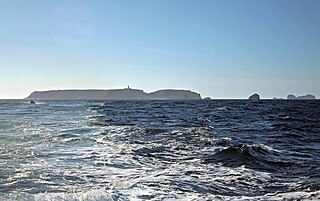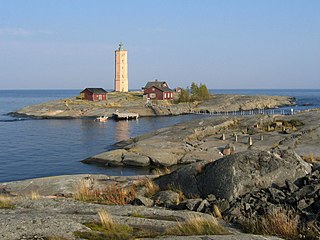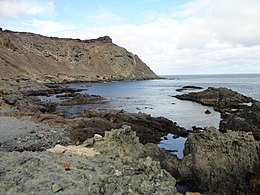
The Berlengas are a Portuguese archipelago consisting of small Atlantic islands 10 to 17 kilometres off the coast of Peniche, Portugal, in the Oeste region. These islands were traditionally known to British mariners as "the Burlings". The only inhabited island is its largest island, Berlenga Grande, although there is currently no permanent habitation in the archipelago. The other islands are grouped into two groups of islets, the Estelas Islets and the Farilhões-Forcados Islets.

The Savage Islands or Selvagens Islands are a small Portuguese archipelago in the North Atlantic Ocean, 280 kilometres (175 mi) south of Madeira and 165 kilometres (105 mi) north of the Canary Islands. The archipelago includes two major islands, Selvagem Grande and Selvagem Pequena, each surrounded by a cluster of islets and reefs, with the total area of 2.73 km2 (1.05 sq mi). The archipelago is administered as part of the Portuguese municipality of Funchal, belongs to the Madeiran civil parish of Sé, and is the southernmost point of Portugal.

Formigas Islets, sometimes referred to as the Formigas Bank, are a group of uninhabited rocky outcroppings in the eastern group of the Azores archipelago, an autonomous region of Portugal. The bank is located 43 kilometres (27 mi) northeast of Santa Maria and southeast of São Miguel, covering a surface area of approximately 9,000 square metres (97,000 sq ft). The submerged Dollabarat Reef is in the same area. The only structure on the islets is a lighthouse located on Formigão, the largest islet.

The Rocas Atoll is the only atoll in the South Atlantic Ocean. It belongs to the Brazilian State of Rio Grande do Norte. It is located approximately 260 km (160 mi) northeast of Natal and 145 km (90 mi) west of the Fernando de Noronha archipelago. The atoll is of volcanic origin and coralline formation.

Feteira is a civil parish in the southern part of the municipality of Horta, on the island of Faial in the Portuguese archipelago of the Azores. The population in 2011 was 1,899, in an area of 14.46 km2. It occupies the southern foothills of the Caldeira Volcano, along the coast. The name Feteira is derived from the Portuguese word for "fern", and indicates a "location of [many] ferns"; the name likely refers to the original colonists' discovery of this area covered with ferns.

The Ilhas Cagarras are an uninhabited archipelago located 5 km off Ipanema, a major beach of the southern coast of the city of Rio de Janeiro, Brazil. They have been designated a federal natural monument since 2010.

The Saint Peter and Saint Paul Archipelago is a group of 15 small islets and rocks in the central equatorial Atlantic Ocean. It lies in the Intertropical Convergence Zone, a region of the Atlantic characterized by low average winds punctuated with local thunderstorms. It lies approximately 510 nmi from the nearest point of mainland South America ; 625 km (388 mi) northeast of the archipelago of Fernando de Noronha; 990 km (620 mi) from the city of Natal; and 1,824 km (1,133 mi) from the west coast of Africa. Administratively, the archipelago belongs to Brazil and is part of the special "state district" of Fernando de Noronha, in the state of Pernambuco, in spite of the very large distance between the two island groups and the even larger distance to the state mainland.

Selvagem Pequena Island is an island in the southeast group of the Savage Islands, Madeira, Portugal. It is the southernmost major island of Portugal. Its fauna and flora are well-preserved due to lack of human interference.

Ilhéu das Rolas is an islet in the African island nation of São Tomé and Príncipe. It lies on the Equator, off the southern tip of São Tomé Island, separated by Canal das Rolas. Its maximum elevation is 96 m (315 ft). Its population was 76 at the 2012 census. It is part of the Caué District. Access to the island is only by ferry from Ponta Baleia on São Tomé Island. There is a lighthouse on the islet, built in 1929, whose focal height is 106 metres (348 ft) and range is 12 nmi. The island is home to a small resort, the Pestana Equador.

Ilhéu Chão is a small islet within the Desertas Islands, a small chain of islands which are in turn within the Madeira archipelago. Chão is located to the southeast of Madeira Island.

The Formiche di Grosseto is a group of islets which emerge sharply in the Tuscan Archipelago. They are located in open sea among the coast of the Natural Park of Maremma and Pianosa, approximately 13 nautical miles (24 km) from Porto Santo Stefano on Monte Argentario and 9.4 miles (15.1 km) from Marina di Grosseto; they are part of the comune of Grosseto and are placed in a nature reserve which makes part of a special protection area.

Monchique Islet is a small uninhabited islet off the coast of the island of Flores, west of the village of Fajã Grande, in the western part of the Portuguese archipelago of the Azores. It is the westernmost point of Portugal and, if considered part of Europe, is Europe's westernmost point as well.

Fora Islet is an uninhabited Portuguese island in the Atlantic Ocean, forming part of the Savage Islands, a dependant archipelago of the autonomous region of Madeira.
Theba macandrewiana is a species of land snail of the family Helicidae, endemic to the Savage Islands of Portugal. Its shell is around 19.4 millimetres (0.76 in) in length.

The Söderskär lighthouse is a decommissioned 19th-century lighthouse in the outer Porvoo archipelago of the Gulf of Finland. It was built in 1862, replacing an earlier unilluminated daymark, automated in 1957, and decommissioned in 1989.

Savage Islands Nature Reserve is a Portuguese nature reserve located in the Savage Islands, a small archipelago in the Northeast Atlantic Ocean. Created in 1971, it is one of the oldest protected areas in the country. The strict nature reserve occupies an area of 2,677 km2 (1,034 sq mi) after its expansion in 2021, and over 99% of the total area is maritime.




















